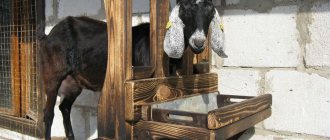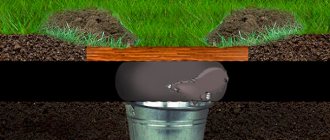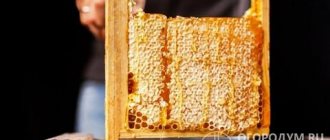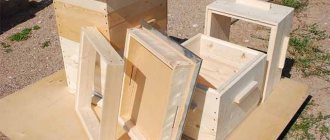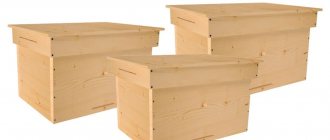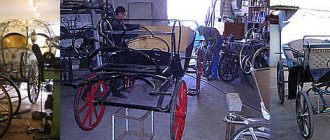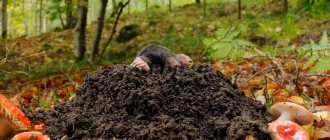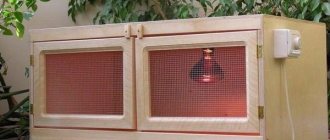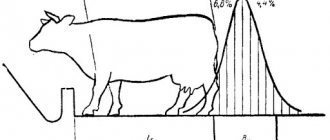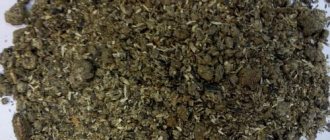In order not to spend money on a ready-made machine for restraining animals, you need to study our instructions, which will tell you how to make a split for cattle with your own hands. This is the name given to a special frame or box for limiting the mobility of a cow. It is indispensable when examining, treating or processing livestock. Ready-made machines are expensive, they need to be ordered, and any modification to suit the customer’s needs only increases the cost. It’s easier, cheaper and more convenient to make such a device yourself.
What is a cow restraining machine used for and how does it work?
A machine that allows you to fix the animal is necessary in order to facilitate manipulation during the processing and trimming of hooves.
The design can also be used in situations involving trimming horns, drawing blood, head surgery, gastric lavage, and administering medications to immobilize the animal for an easier process of performing the necessary manipulations. This machine is a must have in every livestock farm engaged in breeding cattle. The design of the machine is as thoughtful as possible; it takes into account the anatomy of the cow’s body, making an individual inspection possible with enormous time savings. Important! Almost all modern models of fixation machines are small in size, they are quite compact and can be used in small areas and in small barns. To operate the machine, one person is enough, and after purchasing the device, the owner does not incur any additional maintenance costs
The design of the device is quite simple, but safe, there are no sharp corners, and thanks to special leg holders, the animal is securely fixed in one place. The simplest machines have several pipes that must be attached to the wall and floor. To limit the animal's mobility, use chains and movable beams, which are included in the kit. There are special clamps on the beams that allow you to secure your legs with strong leather straps. The head is immobilized by a sheet of metal that follows the shape of a cow's head. Expensive professional machines, in addition to all the above elements, also consist of hydraulic drives and special mechanical devices that are necessary to lift the animal on belts
To operate the machine, one person is enough, and after purchasing the device, the owner does not incur any additional maintenance costs. The design of the device is quite simple, but safe, there are no sharp corners, and thanks to special leg holders, the animal is securely fixed in one place. The simplest machines have several pipes that must be attached to the wall and floor. To limit the animal's mobility, use chains and movable beams, which are included in the kit. There are special clamps on the beams that allow you to secure your legs with strong leather straps. The head is immobilized by a sheet of metal that follows the shape of a cow's head. Expensive professional machines, in addition to all the above elements, also consist of hydraulic drives and special mechanical devices that are necessary to lift the animal on belts.
Some pens have wheels, making the device easy to move around the barn and beyond. In the manufacturing process of the machine, high-strength metal alloys are used, which are coated with anti-corrosion paints in order to ensure a long service life of the device.
Did you know? Eating food for a cow is the most important process; she eats at least 6 hours a day in total and chews food for a very long time, therefore, by placing a feeder with food at the required height at the cow’s head, the manipulation of trimming hooves will be more pleasant.
To watch online, click on the video ⤵
Homemade split for cattle and horses/Handmade/Developing farm More details
Device for servicing cattle. Family farm Hereford Peasant farm More details
We catch the calves and load them through the split into a cattle truck. More details
Device for splitting and beating rams Read more
DIY cattle splitter. More details
How to properly install gates on a farm Read more
Veterinary station "VetMaster". Machine for fixing cattle More details
Split for veterinary treatment of cattle Read more
Machine for restraining livestock (Raskol) More details
universal split for horses KH “MADENIET” No. 2 More details
Complete set of automatic drinkers and their rationality
All automatic drinkers for cattle have a number of required components. The first required element is a bucket for collecting water. In addition, the package includes a level adjustment mechanism that automatically opens the feed when the drinking bowl is empty.
The bowls themselves are supplied with any automatic drinking system. Their quantity depends on the wishes of the customer. The more drinkers, the higher the cost of the system. The kit also includes pipes for water supply. Their footage also depends on the area and number of drinking elements. Some farmers are put off by the cost of automatic calf feeding systems.
Problems of fixing cattle
When examining animals and carrying out preventive or therapeutic manipulations, fixation allows:
- Place the animal in a position that provides good access to the required part of the body;
- Eliminate the possibility of injury to a person;
- Avoid the possibility of injury to the animal itself.
Often, in parallel with “mechanical” fixation, aggressive or frightened animals are given special sedatives.
Based on the position of the animal, fixation is distinguished in a standing or lying position. One of the common techniques in the first case is head fixation, which is done by grabbing the horns with your hands, a rope or a special tool. One of the common devices is the application of special forceps to the nasal septum. Fixation of this rather delicate zone causes the animal to freeze, fearing to injure the septum and to endure most manipulations.
The front and hind limbs are fixed “in the old fashioned way” using various kinds of fetters or ropes, with the help of which the limb is reliably immobilized. Sometimes this function is performed by a tail wrapped around the hind limb - not a single cow would want to tear it off voluntarily. Fixation between two posts with a crossbar located above the withers is widely used, which allows you to attach belts or ropes for fixation in the right places and in the required quantity.
Modern manufacturers offer more specialized equipment - special machines for restraining cattle. The most advanced models combine the capabilities of both standing and lying fixation (for example, as tables for operations).
Clearing the stall
Trimming animals in stalls is more common on private farms. For work, the animal is fixed in the stall with an additional longitudinal crossbar. Using a halter, the animal is tied next to the feeder, limiting head movements. To secure the legs, ropes are used, which can be tied to the support posts of the stall, or fastened together. Working in the stall is impossible without an assistant who will hold the animal’s legs during processing.
An added benefit of a trimming stall is that it has a door at the front. This makes it easier to remove the cow after hoof treatment, since not all animals move backward well. Some farmers equip their stalls with a mechanical apparatus, such as is used in pens, to lift and secure the animal's legs.
READ How to care for a husky puppy?
Materials and mechanisms of structural elements
The durability of the structure and cost depend on the material of the product. You should immediately decide what type of table it will be - steel, aluminum or cast iron. The second important step is to decide on the control mechanism. You should also decide whether the drive should be mechanical or electric. The third step is to select guides. This will affect the processing accuracy of the workpieces.
Base
The following materials are used for the base:
- Cast iron. Expensive, heavy material turns out to be very fragile in operation, so it is used extremely rarely in the production of a drilling machine.
- Steel. The material is the most highly durable and durable. Its main drawback is the cost. Not every master will be able to purchase it.
- Aluminum. Light and soft material is easier to work with. It is not as expensive as steel. But it is not suitable for making a large-sized table, since it will not withstand the heavy weight of large workpieces. This is an ideal option for creating mini-equipment.
Drive unit
The drive is a control mechanism with which the coordinate table will change its position. It happens:
- Mechanical. The easiest way is to make it yourself. It allows you to significantly reduce the cost of the table. The basis is a conventional screw or belt drive - this is enough to set up small-scale production. Mechanics are not capable of providing 100% accuracy, and this is its clear drawback.
- Electric. It guarantees zero error when performing work operations, but it is very difficult to do it yourself. Often found in factory models of tables. If there is no own power source near the workplace, this option will not work.
Models with CNC (computer numerical control) should be included in a separate category of coordinate tables. This is high-tech equipment that is used by large enterprises for production in huge volumes. Their main advantages: good performance, as well as complete or partial automation of the process. Disadvantages: high cost, such a drive is not suitable for some parts.
Guides
The accuracy of the workpiece processing depends on these elements, so they need to be selected correctly. Among those that you can do with your own hands, the following are distinguished:
- Rail. Rectangular guides are considered structurally more advanced. When using them, lower friction losses are observed and serious errors are avoided. It is possible to connect a lubricant supply system.
- Cylindrical. The use of rounded guides is fraught with high heating due to friction. They are suitable for machines of the so-called small category, but you will have to lubricate all the mechanisms manually.
The guides are made with a carriage and bearing units. The use of plain bearings will ensure high precision machining of the part. The use of a rolling shaft support will reduce friction and extend the service life of the manipulator.
The carriage is a block of guides (mechanism assembly) that moves directly along them. It can provide increased flange dimensions, which allows it to be mounted on the underside of the table. If it is not there at all, then the carriage is placed on top (threaded method).
Moving device
When choosing a moving device, you should answer a number of questions:
- What should the processing speed be?
- What positioning accuracy is acceptable when performing work operations.
- How productive the equipment will be used.
A belt moving device is most often used in the manufacture of homemade coordinate tables. It is cost-effective, but has a number of disadvantages. The belt wears out quite quickly and can also stretch during use. In addition, due to its slipping, the accuracy of the moving element is reduced.
Ball screw drive is a more durable and reliable option. Despite the small dimensions of the device, it has a good load capacity, and movement is carried out evenly and with great accuracy. Smooth and almost silent running, as well as high quality surface treatment are not all the advantages of ball screws. However, it also has some disadvantages: high cost and limitations in the speed of rotation of the propeller if its length is more than 150 cm.
Rack and pinion devices provide high speed and accuracy of work, withstand heavy loads, are easy to install and are reliable in operation. The error in rack transmission is extremely low. If their size does not fit, then they undergo a fitting operation.
Boring machines
Metal boring machines
Boring machines are designed to work with large workpieces. Boring machines are widely used in both serial and individual production.
Boring machines can not only carry out drilling and boring, but also more delicate operations, in particular thread cutting and countersinking. Modern boring machines make it possible to perform complete processing of various workpieces without the need for additional equipment. Unlike other machines, boring machines have a horizontal or vertical spindle. A tool for processing workpieces is placed in the spindle. A boring machine uses boring bars with cutters, countersinks, drills, and cutters.
All boring machines are divided into 3 large groups: jig boring machines, horizontal boring machines and diamond boring machines.
Boring machines have the following modifications available for order:
| 262G | 2650F2 | 2A680F1 | IR1400PMF4 |
| 278 | 2651F1 | 2A754V | IR1400PF4 |
| 2410 | 2651F2 | 2А776В | IR1600MF4 |
| 2411 | 2653F1 | 2А777В | IR1600F4 |
| 2421 | 2655GF1 | 2A78 | IR200PM1F4 |
| 2431 | 2655DF1 | 2A78N | IR200PMF4 |
| 2450 | 2655F1 | 2B460 | IR2637KMF4 |
| 2455 | 2655F2 | 2B460A | IR2637KF4 |
| 2457 | 2705V | 2B660F1 | IR2637PMF4 |
| 2458 | 2705P | 2V423 | IR2637PF4 |
| 2459 | 2706A | 2V440A | IR320PMF4 |
| 2615 | 2706V | 2B460 | IR500 |
| 2620 | 2706P | 2V620 | IR500PMF4 |
| 2622 | 2706С | 2V622F11 | IR600 |
| 2636 | 2711B | 2V622F11-1 | IR800MF4 |
| 2637 | 2711P | 2V622F13 | IR800PM1F4 |
| 2656 | 2712V | 2V622F4 | IR800PM8F4 |
| 2657 | 2712P | 2G660GF2 | IR800PMF4 |
| 2665 | 2713B | 2G660F2 | IS1250 |
| 2431С | 2713P | 2D450 | IS1250PMF4 |
| 2431SF10 | 2714V | 2D450AMF2 | IS1250PF40 |
| 243VMF2 | 2733P | 2D450AF10 | IS1250S |
| 243VF2 | 2754V | 2D450AF2 | IS2000 |
| 2440SF4 | 2776V | 2D450PR | IS2A636 |
| 2455AF1 | 2777V | 2E440A | IS2A637 |
| 2455I | 2781B | 2E450A | IS320 |
| 245VMF2 | 2781P | 2E450AMF4 | IS320GLOBUS |
| 24K40SF4 | 2782V | 2E450AF1-1 | IS500PMF4 |
| 24K60AF4 | 2782P | 2E450AF30 | IS630 |
| 24K70AF4 | 278L | 2E450AF4 | IS800 |
| 24K70SF4 | 278N | 2E460A | IS800GLOBUS |
| 2614F1 | 2A430 | 2E460AF1 | IS800PMF4 |
| 2620V | 2A450 | 2E470A | KU533 |
| 2620VF1 | 2A450AF10 | 2E470AF1 | KU533MF4 |
| 2620G | 2A459AM1F4 | 2E470N | LG7 |
| 2620GF1 | 2A459AF4 | 2E656 | LG8 |
| 2620D | 2A470 | 2E78L | LR355F1 |
| 2620E | 2A620 | 2E78P | LR372F1 |
| 2620F11 | 2A620-1 | 2L450A | LR380F1 |
| 2622V | 2A620F1 | 2L614 | LR395PMF4M |
| 2622VF1 | 2A620F11 | 2L614F1 | LR434F4 |
| 2622G | 2A620F1-1 | 2M614 | LR501PMF4 |
| 2622GF-1 | 2A620F1-2 | 2M614G | LR521PMF4 |
| 2622D | 2A620F2 | 2M614GF1 | LR543MF4 |
| 2622K | 2A622 | 2M615 | LT520 |
| 2622P | 2A622-1 | 2M615G | MSG1200MF4-1 |
| 2623ПМФ4 | 2A622MF2 | 2M615GF1 | MSG1200F13-1 |
| 2623PF4 | 2A622MF4-1 | 2N636GF1 | MSG1200F4-10 |
| 2627MF4 | 2A622PF1 | 2N636F2I-01 | MSG6062MF4 |
| 2627ПМФ4 | 2A622F1 | 2N636F2I-11 | MSGP6101MF4-10 |
| 2627PF4 | 2A622F2 | 2N637GF1 | MSGP6101MF4-6 |
| 2636G | 2A622F4 | 2N637F2I-01 | MSGP6101MF4-8 |
| 2636GF1 | 2A636F1 | 2N637F2I-11 | MSGP6101F13-10 |
| 2636GF2 | 2A636F2 | 2P637MF4 | MSGP6101F13-6 |
| 2636F1 | 2A637F1 | 2Р637 | MSGP6101F13-8 |
| 2637G | 2A637F2 | 2Р637-10 | RT965 |
| 2637GF1 | 2A656RF11 | IR1250PMF4 | RT965F3 |
| 2637GF2 | 2А656Ф11 | IR1250PF40 | SRS-2I |
| 2637F1 | 2A660F1 | IR1250F40 | |
| 2650F1 | 2A680 | IR1400MF4 |
Horizontal boring machines differ from other models in the horizontal arrangement of the spindle. In the process cycle, the required movements are communicated to the individual components. The main movement of the device is the rotational-translational movement of the spindle along its own axis. The movement can be communicated either directly to the tool in the spindle or to the workpiece, which is mounted on the table. In these machines, auxiliary movements are also distinguished. These include movement of the headstock in the vertical plane and movement of the table in two coordinates.
Jig boring machines are used to work with various holes. Boring machines make it possible not only to work with holes of various diameters, but also to take into account the relative position of certain components relative to the reference plane. This type of machine is very widely used in serial industry. It is also possible to make markings. To more accurately measure movements, new generation machines are equipped with additional measuring instruments, in particular optical devices. Universal rotary tables make it possible to work with workpieces in a polar coordinate system. There are machines with two and three racks. The main movement in the machine is the movement of the spindle.
Working on the machine
In order for the procedure to be beneficial, you need to know how a cow’s hoof works. Only the top layer of the hoof must be removed; it is constantly growing and as it grows, various irregularities and sagging appear. They cause great inconvenience to the cow; the animal even begins to limp because of this.
But at the same time, the top layer is necessary, it protects the inside. When the top build-up becomes too large, it develops cracks. This entails serious troubles in the form of diseases that negatively affect the productivity of the cow.
In order not to harm the animal, you must follow the rules for trimming hooves:
- If the cow is kept in a stall, trimming is carried out three times a year. For loose housing, two times is enough.
- In order to soften the hooves as much as possible before the procedure, it is recommended to keep the animal on a damp bedding for a day.
- All instruments used must be pre-disinfected.
- The cow must be properly and securely secured in the device to eliminate the possibility of injury. The cow is led to the pen on a leash; you can lure her into the cage with food.
- Sometimes a sedative is required. All actions are carried out as calmly as possible, this is the only way the cow will not become stressed.
- First of all, the hooves should be properly cleaned of dirt and disinfected.
- During the cutting process, you need to ensure that the inner layer is not affected. If this happens, an inflammatory process may develop. The old layer of the hoof can be identified by its characteristic gray color, and this should be cut off. They remove it until the white color appears - the inner layer of the hoof.
There should be no sharp edges left; everything should be carefully sharpened with a file. A special cutter is suitable for leveling; scraps of wool are removed with scissors.
You can determine whether the procedure was carried out correctly using a tester or a flat surface of a knife. The hoof is placed on the surface and if it lies flat, then everything is done correctly.
Advice from experienced livestock breeders
Some tips:
- Although a wooden machine is relatively easy to make, it will not have the same durability as a metal one.
- It is advisable to install the machine at the exit of the barn. In this case, you do not have to make any special efforts to bring the animal there.
- The hoof should be trimmed until the white color appears, which means that the stratum corneum has been completely cut off.
- If the hoof was injured during work, you need to cauterize it with iodine.
The use of a special machine for fixing the animal when processing hooves will significantly facilitate this processing.
0 0 votes
Article rating
What types of drinkers are there?
As was said, one of the components for good milk yield and weight gain of livestock is the supply of sufficient clean water. The type of equipment that will be used depends on the type of animal housing:
- The group type of drinking bowls for cattle is suitable for places where animals are kept without a leash. Typically, these are stationary automatic drinkers installed on farms, and mobile models intended for watering livestock on grazing.
- Individual. Suitable for those farms where animals are tethered.
- Multi-level. Drinkers are installed for livestock kept at different levels.
Drinkers for rabbits
During the cold season, water is supplied to animals without any special differences from summer time, but only if the required temperature is maintained in the room. For this purpose, a plastic design is the best option. In general, the farmer will only benefit if heated drinking bowls for cattle operate indoors in the winter. Comfortable conditions created for animals will only increase milk production and contribute to weight gain.
Additional Information! Calves are not given water from drinking troughs for bulls and cows. They are not kept together. For young animals there is a special room with special equipment and design requirements.
What promotes hoof growth?
The top layer of the hooves grows quickly; in a month its thickness can increase by 6-8 mm. If a cow grazes, then such growths can wear off spontaneously, but animals kept in stalls suffer greatly from this. Growths on cattle hooves quickly lead to lameness of animals, since the hooves become deformed due to growths. Pregnant cows are especially susceptible to this - the stratum corneum grows fastest during this period.
Rapid growth of the top layer depends on many factors, the main one of which may be poor flooring in the stalls. This can also be caused by improper nutrition of cows - if the food contains a lot of carbohydrates, but is sorely lacking in fiber. Another factor is the quality of bedding in the stalls. If it is dry and plentiful, then the likelihood of cows having hoof problems is minimal.
How to put a cow in a pen and trim its hooves
Since the restraining machine is installed at the exit of the barn, there is no need to specifically drive cows into it. Before going outside, the cow will enter the pen on its own; you only need to timely fix the animal’s head in the recess for the neck clamp. Once the neck is secured, the back gate is closed to prevent other cows from getting into the structure and interfering with the procedure.
Usually cows behave calmly in such pens, so without much effort you will fix the necessary hoof, which will be trimmed. The front hooves are trimmed first, then the back hooves.
For the procedure, use a special knife for trimming hooves, a cutter or a milling cutter, carefully cutting off the old hoof horn from the sole and crumb.
This part is characterized by a gray color, it is brittle and fragile, and cannot be confused with the “living” part of the hoof. The young hoof horn is light and elastic, so the old part is cut off until a white line appears.
The procedure must be performed as carefully as possible so as not to touch the young area. In this case, it is better to stop earlier, without finishing the hoof a little, rather than injure it. If it is still not possible to avoid injury, the wound is immediately treated with iodine.
Each subsequent hoof is treated in the same way, having previously fixed it. After all the hooves have been trimmed, the cow's last leg is initially released from the clamp, the front gate is opened, freeing the animal's head from the neck clamp, and the cow calmly goes outside. After this, the back gate opens and the next animal enters the split to carry out the procedure.
Treatment of cattle hooves
Over time, the hooves become overgrown with a keratinized and dead layer, which is susceptible to cracks and can cause damage.
Commander plus for processing potatoes: instructions
To process, the keratinized layer is cleaned off before the living part of the hooves appears; it must be cleaned so as not to damage it. Here it is better to trim not completely than to damage this part of the hooves. This can cause animal fear.
Note! If there are wounds, they are treated with disinfectants. It is believed that the procedure must be repeated at least once a year.
Operating principle of the cow restraining machine
Cows are large animals that can easily injure humans. The machine allows you to process hooves, cut off horns, and conduct veterinary examinations without stress for the animal or danger for the farmer. A hoof stand is a stall with a frame into which the animal’s head is inserted; a wide belt is used to secure the cow under its belly; additional belts are used to secure the limbs in the position desired by the owner.
There are industrially manufactured machines. They are durable, metal, with wheels that allow you to move the structure, and an electric drive that can lift the back of the animal.
Expert opinion
Zarechny Maxim Valerievich
Agronomist with 12 years of experience. Our best country expert.
Ask a Question
Such products are expensive and are purchased by large farms. The cost depends on the type of product; there are: mechanical, electric, hydraulic and wheeled models.
Advantages and disadvantages
The machine for immobilizing an animal is convenient for livestock breeders. Despite a number of advantages, there are also disadvantages when using it.
Advantages and disadvantages
Painless fixation of the animal. The device does not harm internal organs, does not injure the cow, or crushes it. When entering the pen, the cow does not feel any discomfort. A person receives protection from possible injuries during the processing of an animal. The machine allows you to trim and process hooves, horns, carry out medical procedures, and surgery. The device is operated by one employee. No additional assistance is required. When using the machine, the number of cows processed per day increases.
The machine must have support and weight, otherwise injury to livestock and humans is inevitable when it tips over. Incorrect placement of the belts complicates the task and leads to injury to the animal. Lateral fixation in the device leads to injury. Experienced professionals choose machines with vertical fixation. Cattle experience stress if there is no support in the structure. The cow may slip if the floor of the unit is uneven.
Why does a cow kick when milking?
Before looking for ways to calm animals that kick during milking, you first need to consider the reasons why they behave this way.
- A sudden change in environment causes severe stress in cows; as a defense mechanism, the animal does not allow itself to be milked. This usually happens when an adult is purchased and transported to a new place.
- Mastitis at any stage of development. It brings great discomfort to the animal and causes quite severe pain when the udder is compressed.
- When milking, a cow may kick due to improper technique. Discomfort and severe pain can be the cause of the animal’s abnormal behavior.
- Injuries to the nipples and udder. They can also be the reason why a cow kicks during milking. Before each milking, it is necessary to inspect the udder for damage and, if necessary, treat it with disinfectants and wound-healing agents.
- Lack of proper milk collection schedule. Without it, the cow does not have the correct daily routine, and the animal will react negatively to any outside interference.
- Excessive cow fatigue can also cause a cow to kick during milking. This process requires effort not only from the person, but also from the cow itself, and a tired animal does not want to strain even more.
It is very important to understand that the process of milking a first-calf heifer and an experienced cow is very different. In the first case, you need to be patient and put a lot of effort into teaching the animal to behave correctly.
Useful tips
The instructions, which describe how to make a coordinate table with your own hands, explain the process step by step. However, minor problems may arise during operation. To avoid them, it is recommended to adhere to safety precautions and take into account the advice of experts. The most important of them:
- if you plan to process plastic or wood, then the base of the manipulator can be made of aluminum;
- with device dimensions of 35 x 35 cm, it is advisable to adjust the total length of the guides to 30 cm;
- to protect the device from chips before installation, it is recommended to place a piece of plywood under it;
- when using cylindrical guides, there is no possibility of connecting a lubrication supply system, so all parts must be lubricated manually;
- When assembling, it should be taken into account that the plain bearing provides better machining accuracy, while its counterpart (friction bearing) leads to some play.
Drawing of a dressing table for making it yourself, stages of work
To carry out welding work, safety precautions must be observed. It involves the use of special clothing, a protective mask (shield), suede or tarpaulin gloves. The room in which the assembly is carried out must be ventilated or have a high-quality exhaust hood. When working outdoors, a canopy is required. Near the workplace, means and materials must be prepared to extinguish a possible fire.
The manufacture of a simple type coordinate manipulator can be mastered by a master with welding skills. It is not difficult to obtain a reliable and convenient product if you strictly follow the conditions of the drawing and the assembly algorithm. The home device allows you to engage in small-scale production of metal, wood, and plastic parts. The service life of such a device depends entirely on the quality of installation and the volume of drilling and milling work performed.
- https://mekkain.ru/library/stol-povorotnyij.html
- https://mebel-sovet.ru/stoly/samodelnye/1-koordinatniy-stol-svoimi-rukami
- https://StanokGid.ru/osnastka/koordinatnyjj-stol-dlya-stanka-svoimi-rukami.html
- https://mblx.ru/prilavok/samodelnyj/1453-koordinatnyj-stol-svoimi-rukami.html
- https://met-all.org/oborudovanie/stanki-sverlilnye/koordinatnyj-stol-dlya-sverlilnogo-stanka-svoimi-rukami.html
- https://stankiexpert.ru/tehnologicheskaya-osnastka/prisposobleniya/samodelnyi-koordinatnyi-stol.html
- https://USamodelkina.ru/11815-koordinatnyj-stol-s-tiskami-iz-ugolka-svoimi-rukami.html
What is a cow restraining machine used for and how does it work?
A machine that allows you to fix the animal is necessary in order to facilitate manipulation during the processing and trimming of hooves. The design can also be used in situations involving trimming horns, drawing blood, head surgery, gastric lavage, and administering medications to immobilize the animal for an easier process of performing the necessary manipulations.
This machine is a must have in every livestock farm engaged in breeding cattle. The design of the machine is as thoughtful as possible; it takes into account the anatomy of the cow’s body, making an individual inspection possible with enormous time savings.
Some pens have wheels, making the device easy to move around the barn and beyond. In the manufacturing process of the machine, high-strength metal alloys are used, which are coated with anti-corrosion paints in order to ensure a long service life of the device.
Rules for care and breeding
When breeding cattle, you need to try very hard to raise a cow from a calf. Therefore, livestock farmers are trying to look for and apply various ways to reduce costs and increase the efficiency of their activities. Unfortunately, in the rush to apply advanced work methods, they forget about the basic rules that must be followed to care for animals.
One of the most important issues is ensuring hoof health. Over time, they can become damaged and become overgrown with a keratinized, dead layer. If they are not helped, this can reduce the productivity of animals. For example, scientists have calculated that in such cases, for various breeds, milk yield decreases by an average of 14%, fertility indicators - by 16%. In addition, there is an increase in the cost of treating a sick animal.
Rules for care and breeding
Modern MBS for hole machining
The development of innovation and technology opens up new conditions for manufacturers. The introduction of program control systems completely eliminates human participation in the operation of the machine. New generation boring machines are equipped with the latest control systems and the specialist only needs to install the machine in the required position or fix the part that needs to be processed.
Experts who use the presented systems note the ease of use and the presence of a large number of auxiliary devices. Therefore, it is quite easy to carry out work using machines of this type.
- 5
- 4
- 3
- 2
- 1
Equipment care
Modern models are easy to use and safe for livestock. One person is enough to operate. The device is compact, small in size, suitable for any type of barn. The split does not require special skills to maintain it.
A wooden machine standing outdoors must be impregnated with a solution that protects it from rotting. The bars are carefully processed so as not to injure the animal. Anti-corrosion metal is used in metal structures. Taking good care of cattle will increase productivity and avoid diseases.
Do-it-yourself anti-kick for cows
Treatment of grapes from diseases and pests - processing time
This device is designed to limit the cow's mobility during milking. There are one-sided and two-sided anti-kick options.
The first of them is considered classic. This anti-kicking for cows looks like this.
Antibryk
The lower part is hooked onto the fold that runs forward from the cow's hind leg. The upper part extends beyond the spine. The button that looks out of one of the holes is located on a spring bar, which pushes it out into the holes, fixing the overall length of the device. If you press the button, you can change the length of the anti-kick. If it is too loose for the animal, it will not be effective. You need to adjust the length to make it fit tight.
To make an anti-kick for cows with your own hands, you need to make the following parts, according to the diagram.
Anti-kick circuit
You will need two curved pieces of pipe A with one hole each, which will need to be inserted into the symmetrical curved pipe B, which has a larger diameter. First you will need to insert an angular spring D into them, so that the button fits into the hole. When inserting pipes, the buttons must be pressed using the palm of your hand. Rubber caps must be placed on the outer ends of the pipes to protect the cow from being scratched. Here's how to make your own anti-kicker for cows using metal parts.
Important! The size of the device must be such that it is suitable for the cows on which it is intended to be used
We use metal
To make a metal split with your own hands, weld several profile pipes 60x40x3 or 40x40x3 mm (you can use round ones with a diameter of 8-10 cm) so that you get a rectangular pen measuring 1x2 m.
Strengthen it by adding a few more pipes along the long side to give the structure stability and rigidity. Provide free access from the sides: weld opening panels or grilles.
Equip the short sides of the box with gates. The rear one can be hinged or sliding, but must have a strong lock.
The front gate must have a recess for a neck clamp. Weld strap lugs to secure additional straps that can be passed under the cow's belly. This will help lift it if necessary and keep it suspended. Clean and paint the box.
Was the article useful? Share it with your friends.
DIY making
The manufacture of a device for boring on a milling machine should begin with a quill.
- Make a drawing of the future head.
- Cut a piece of square steel that fits the size of the quill.
- Plan the guides.
- Make holes on the opposite plane for fastening with a shank.
- Drill and tap threads in the side planes. The bolts that clamp the slide will be screwed into them.
- Make reciprocal guides on the slider.
- Select shelves on the opposite side, leaving a protrusion for the tool holder.
- Mill a groove for the cutter stem. Drill holes on the side and cut an M6 thread. The bolts that clamp the tool will be screwed into them.
The shank must have a cone of the same number as the spindle. A quill is attached to it.
The boring head turns a simple milling machine into a universal one. After milling, drilling and boring of holes of different diameters are performed on it from one installation of the part. This greatly simplifies processing and increases productivity.
How cows are slaughtered
Proper slaughter of livestock directly affects the quality of meat products. That is why this should be done by a qualified specialist.
A prerequisite is to obtain permission from a veterinarian to use animal meat for food.
First of all, before the procedure, the animal should not be fed for a day, but only given water to drink.
Preparation
The slaughter of livestock should be carried out by a professional, even if the procedure is carried out at home, as difficulties may arise during the process.
Figure 1. Stunning and slaughtering a cow
Cow preparation also plays an important role. First of all, the cow is not fed during the day, and water is given no later than 3 hours before slaughter. This simplifies the skinning and cutting process.
But the most important condition for preparing a cow for slaughter is the calmness of the animal. Unfortunately, the animals feel the approach of slaughter and begin to get nervous. To prevent the cow from being stubborn, the place is prepared at a distance from the place where the cow and other animals are kept.
It is also important to obtain a slaughter permit from a veterinarian. The animal must be absolutely healthy, and if it has recently been vaccinated, the doctor may prohibit slaughter, since the meat of such cattle can be dangerous to human health
Stun
Before slaughter, the cow is taken to a previously prepared place and tied to a crossbar by the horns and neck. Then the animal must be stunned by hitting the joint of the occipital bone and the first vertebra with the blunt side of an ax or any other heavy blunt object (Figure 1). From this blow the animal loses consciousness for several minutes. During this time, you need to cut the cervical artery and hang the carcass to drain the blood.
Home slaughter
Home slaughter of cows must be carried out in accordance with all rules and hygiene standards. At home, not only the stunning method is used, but also firearms.
In case of stunning, the artery is cut with a sharp knife, and cutting begins after the carcass is completely bled. If the procedure is carried out with a firearm, aim at a point located on the forehead between the eyes. In some cases, one shot may not be enough to kill the animal.
Why do you need to prune?
This procedure should never be neglected, since it allows you to prevent a number of negative consequences. These include:
- Damage to the claw. When animals graze on pasture, they move around a lot, so a natural shedding of dead, hard epidermis occurs. At the same time, the stratum corneum constantly grows (by about 7-8 mm per month) and replaces the worn-out part. When animals lead a stalled lifestyle and move little, this layer grows much faster than it wears off. Typically, the period of its intensive growth occurs in autumn-winter. Due to this, the hooves crack, bend and become deformed.
- Ligament sprain. If the stratum corneum is not removed for a long time, the ligamentous apparatus will be greatly stretched, so the animals will be more susceptible to hoof diseases than usual. In this case, it will be quite difficult to correct the situation, since the ligamentous apparatus is practically irreparable.
- Lameness. Violations of the hoof horns and damage to the hooves due to untimely trimming of them lead to various diseases, which provoke lameness of the animal. These diseases include: sole ulcer;
- footrot;
- digital dermatitis;
- white line disease.
- finger dermatitis;
Thus, if you trim the hooves in a timely manner, you can completely eliminate various diseases of the cow, and also achieve the following goals:
- improve the condition of the herd;
- increase milk production;
- provide the cows with ease of movement.
